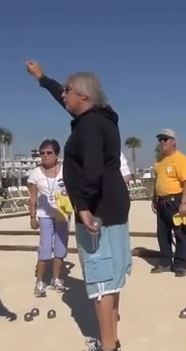 As a new petanque player, interested in improving his throwing form, I have a question.
As a new petanque player, interested in improving his throwing form, I have a question.
When do you unwind your cocked wrist?
When you throw a high lob, during your backswing your wrist is really cocked — the hand holding the boule is curled up toward the underside of your forearm. And when you finish your throw, you’ve uncoiled that curled wrist so that your hand is open and your fingers are pointing up and out. Uncoiling that curled wrist is how you get backspin, retro, on the boule.
My question is
When does that cocked wrist get uncoiled?
Does it gradually uncoil as the swing progresses?
Or does it stay coiled during most of the swing, and only uncoil quickly at the end of the swing?
The answer (or at least, one answer) can be found in a YouTube video of a clinic that Marco Foyot taught at Amelia in 2012. In the video Marco demonstrates the motion of throwing a high lob. You have to watch closely. The demo starts at 4m 38s, and it is over in about 3 seconds.
Here are some stills from that video.
For the high lob, Marco doesn’t take a big backswing. (In fact, he doesn’t ever seem to use a big back swing.) He starts with his throwing hand and the boule low. In this picture, he’s just starting to raise his arm — he looks as if he’s going to hit the lady in the background with the back of his wrist.

The swing progresses. Higher. And higher. Note that in picture C, even when his wrist has been raised above his head, Marco’s wrist is still cocked.
A
|
B
|
C
|
Only when his arm at the very top of the swing, does Marco snap his wrist.
So that pretty much answers my question — the wrist uncoils at the end, with a snap.
Studying these pictures, I’ve noticed a couple of other interesting things. One of them is that Marco’s hand is very high — above his head — when he snaps his wrist and releases the boule. Here is a picture from a clinic he taught in Zanesfield, OH in September 2013.
The other is that Marco’s arm doesn’t seem to be moving in a swing or an arc from his shoulder. If you look at pictures A, B, and C, you will see that his hand is moving almost vertically straight up. That means that most of the force of the throw is UP — there is relatively little OUT.
 That makes sense, but I’m going to have problems digesting it. I’m a big fan of Artem Zuev’s Art of Petanque blog. His advice to think of your throwing arm as a pendulum (a ball on a string) makes a lot of sense to me, and is a style that I’ve been trying to achieve. But Marco’s definitely not doing “ball on a string” when he throws a high lob.
That makes sense, but I’m going to have problems digesting it. I’m a big fan of Artem Zuev’s Art of Petanque blog. His advice to think of your throwing arm as a pendulum (a ball on a string) makes a lot of sense to me, and is a style that I’ve been trying to achieve. But Marco’s definitely not doing “ball on a string” when he throws a high lob.
One of the things that is hard to realize is just exactly how high a REALLY HIGH lob is. On YouTube, there is a nice video of Bruno Leboursicaud demonstrating a fantastically accurate high lob. In the video, you can’t see how high the lob is, but from the time it takes to come down, you know it must have been really high.
Fourtunately for us, Zanesfield Petanque has posted a video on its Facebook page showing Marco demoing a high lob during his clinic there. On his second throw (which you can see in the photo at the beginning of this post ) you can actually see how high his lob is.
Here is Marco at the World Championships in Thailand, in 1993.










